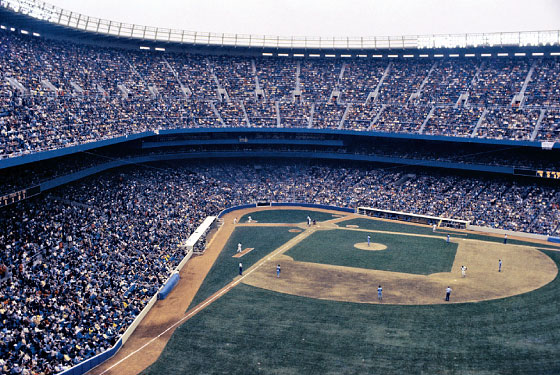
The Yankees are pretending that, with a final, unimportant game this Sunday, they’re leaving the house that Ruth built: the majestic stadium that opened back when Harding was president. Wrong. That park died in 1973. In its place is a typical seventies improvisation, gritty, rickety, and ugly, something not built for the ages but just good enough to get us through the bad times.
It’s how we got to keep the Yankees. Herman Franks, an old backup catcher and manager who made big money in construction, had hoped to buy the team from CBS and move to the grim sports complex New Jersey was building in the Meadowlands. Yankees president Michael Burke persuaded Bill Paley to take the city’s $100 million renovation and a lower buyout, from a group headed by an obscure Cleveland shipbuilder named George Steinbrenner.
In the process, the stadium lost all of its original grandeur and eccentricity. Gone was the old playing field, with its vast skew to “Death Valley” in left-center and the chip-shot right-field porch. Gone were the green wooden seats. They pulled the flagpole and the monuments off the playing field—the granite slabs so rooted that kids used to believe the Yankee greats were actually buried in left field. They replaced the old concrete façade—painted brown, then white, so it looked like the stone of an actual cathedral—with some sort of hollow plastic covering that felt as if you could tear it off with your hands.
Throughout the seventies, though, the stadium seemed to mirror perfectly the city it served. It was a place of brilliant, outrageous disorder. The Yankees’ enormously talented players squabbled and schemed like Borgias, under the dubious supervision of their pathological manager. Their big star was no living demigod like Ruth or Mantle but the easily bruised, all-too-human Reggie Jackson. In center field, there was no longer the regal DiMaggio but that amazing trickster icon, Mickey Rivers, lugging his bat to the plate like an old peasant hauling firewood. Mick the Quick, by no means the best player in the game but the man who just seemed to make things happen, the one who handed the magic bat to Bucky Dent. Rivers’s particular Zen philosophy sounded like a mantra for the New York of his day: “If you have no control over something, ain’t no sense worrying about it—you have no control over it anyway. If you do have control, why worry? So either way, there ain’t no sense worrying.”
During game two of the 1977 World Series, Howard Cosell, watching the flames rise outside the walls, cried, “Ladies and gentlemen, the Bronx is burning!” By game six, as Jackson pounded titanic home runs into the night, scores of drunken young men sat with their legs dangling over the right-field wall. When they charged onto the field, they were met by a riot squad, who clubbed away not only at the rowdies but also at families celebrating on the grass. That, too, was so much the New York of the time, ridiculous indulgence followed by brutal overreaction.
Nonetheless, it was a good place to see a game. For just $2.50, less than the price of a movie, you could buy a seat in the upper deck, with a commanding view of the whole playing field and the poignant urban vista beyond. You could smoke pot with impunity. Like so many New York places, the stadium was more accessible, more integrated, more communal then.
Outsiders didn’t get it, looked on in horror at what Roger Angell called “the stadium hordes, yowling into the night like coyotes.” After the Yanks slugged the Dodgers here in the 1978 World Series, L.A. shortstop Bill Russell complained that “with 56,000 screaming people out there, it’s hard to concentrate … The fans are the worst. The city is the worst.” Teammate Rick Monday concurred, “I don’t like the park, I don’t like the town. I don’t understand their way of life.”
But we knew what we had, this splendid bacchanal, this life during wartime. In the eighties, the team, like the town, seemed to lose focus. Steinbrenner tried to blame his failures on us. The Bronx was too dangerous, he claimed; people were scared to come out to the ballpark, and besides, they couldn’t find parking. He spoke of moving somewhere, anywhere.
And then, suddenly, just like the city, the Yanks were back. Attendance shot up over 4 million, the crowds probably whiter and more affluent than they’ve been since at least the fifties, maybe ever. Steinbrenner clamored for a Manhattan stadium, but allowed himself to be bought off for $800 million. The new stadium will have 5,000 fewer seats and even more corporate luxury boxes. It will look like a cathedral again, a symbol of the flush times in which it was conceived. Now the gritty, temporary plastic park can go, the faint yowls of the coyotes still echoing in the Bronx night.
Have good intel? Send tips to intel@nymag.com.